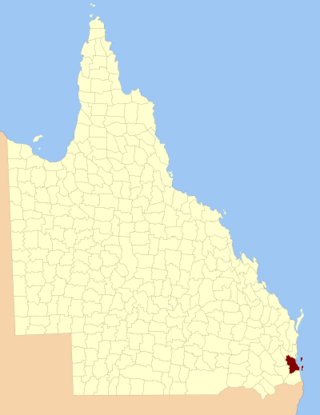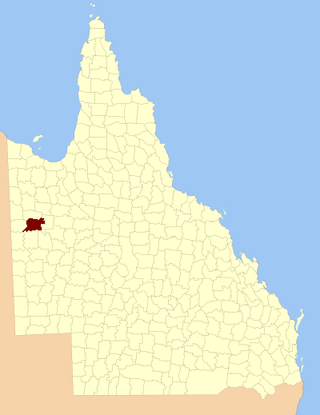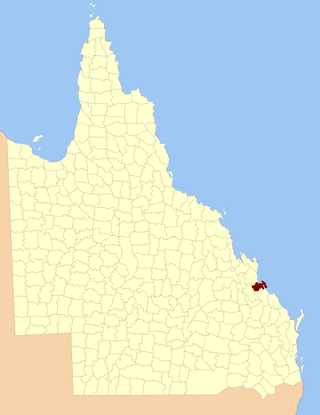
The County of Stanley is a cadastral division centred on the city of Brisbane in Queensland, Australia, that is used mainly for the purpose of registering land titles. It was named after Edward Stanley, who was three times British prime minister in the 1850s and 1860s. It is bounded by the Logan River in the south, the Brisbane River at what is now Lake Wivenhoe in the west, the Stanley River at what is now Lake Somerset in the north-west, and Caboolture River in the north. It includes Moreton Island and Stradbroke Island, and extends west to Ipswich's CBD, south to Loganlea and north to Morayfield.

The County of Ward is a county in the south-eastern corner of Queensland, Australia. The main urban area within the county is the city of the Gold Coast, and it also extends to include the southern parts of the West Moreton region centred on Beaudesert and Boonah.

The County of Canning is a county in Queensland, Australia. The county consists of almost all of the former Shires of Caboolture, Maroochy and Kilcoy and the former City of Caloundra. Its main urbanised areas are centred on the Sunshine Coast and the areas surrounding Caboolture.

The County of Balurga is a county in Queensland, Australia. It is located in Far North Queensland, east of Kowanyama on the Cape York Peninsula. On 7 March 1901, the Governor issued a proclamation legally dividing Queensland into counties under the Land Act 1897. Its schedule described Balurga thus:
Bounded on the north by the counties of Kalkah and Lukin; on the west by the county of Koolatah; on the south by the south boundaries of Koolatah, Koolatah No. 4, Koolatah No. 7, Cootah No. 2 and Cootah No. 3 Blocks; and on the east by the east boundaries of Cootah No. 3, Cootah No. 1, Goathland No.3 and Goathland No. 9.

Wicklow County is a county in Queensland, Australia, located in the Wide Bay–Burnett region. On 7 March 1901, the Governor issued a proclamation legally dividing Queensland into counties under the Land Act 1897. Its schedule described Wicklow thus:
Bounded on the east by the county of Yarrol; on the south by the county of Newcastle; on the west by the eastern watershed of the Dawson River; and on the north by the south boundaries of Knockbreak Lease, Calrossie Resumption, Culcragie Lease, part of Culcragie Resumption, and by the north boundary of Eidsvold Resumption.

The County of March is a county in Queensland, Australia. The county consists of the Noosa area, plus the eastern parts of the Gympie and Fraser Coast regions.

The county of Dagmar is a cadastral division of Queensland north-west of Cairns. It contains the town of Julatten.

The County of Carlisle is a county in Queensland, Australia. The county is centred on the city of Mackay and includes most of the Mackay Region. It takes its name from Carlisle in England.

The County of Livingstone is a county in Queensland, Australia. It is centred on the city of Rockhampton and includes most of the Rockhampton Region. The county was created on 1 September 1855 by royal proclamation under the Waste Lands Australia Act 1846. On 7 March 1901, the Governor issued a proclamation legally dividing Queensland into counties under the Land Act 1897. Its schedule described Livingstone thus:
Bounded on the south by the county of Deas Thompson and the southern boundaries of the parishes of Plews, Bouldercombe, Mooninera and Playfair; on the west by the western boundaries of the parishes of Playfair, Stanwell, Neerkol, Limestone, Morinish, Yaamba, Canoona and Werribee; on the north by the northern boundaries of the parishes of Werribee, Rosslynn and Yeppoon, and on the east by the Pacific Ocean,—inclusive of Great Keppel, North Keppel, and other adjacent islands.

The County of Rochedale is a county in Queensland, Australia. The county is divided into civil parishes. It is centred on the city of Mount Isa, its only population centre. On 7 March 1901, the Governor issued a proclamation legally dividing Queensland into counties under the Land Act 1897. Its schedule described Rochedale thus:
Bounded on the north by the county of Brahe and parts of the west and south of Glenvale No. 2 Block to the Leichhardt River, by that river upwards to the north-west corner of Parkside No. 1, by the north, east and south boundaries of that block, part of the south and east boundaries of Parkside No. 2, part of the north, the east, and south boundaries of Parkside No. 5, and the east boundary of Parkside No. 8 Block; on the south by the counties of Chapworth, Waverley and Piturie; and on the west by the county of Nash.

The County of Clinton is a county in Queensland, Australia. It is centred on the city of Gladstone and includes most of the Gladstone Region. The county was created on 1 September 1855 by royal proclamation under the Waste Lands Australia Act 1846. On 7 March 1901, the Governor issued a proclamation legally dividing Queensland into counties under the Land Act 1897. Its schedule described Clinton thus:
Bounded on the south by the county of Yarrol; on the west by the county of Rawbelle and the eastern watershed of Callide Creek and the Don River; on the north by the northern watershed of the Calliope River; and on the east by the Pacific Ocean and the county of Flinders.

The County of Dawson is a county in Queensland, Australia, located in the Shire of Banana in Central Queensland. The county is divided into civil parishes. The county was officially named and bounded by the Governor in Council on 7 March 1901 under the Land Act 1897.

The County of Ferguson is a county in Queensland, Australia, located in the Shire of Banana in Central Queensland. The county is divided into civil parishes. The county was officially named and bounded by the Governor in Council on 7 March 1901 under the Land Act 1897.

The County of Raglan is a county in Queensland, Australia, located mostly within the Shire of Banana in Central Queensland. The county was first created in January 1854 by the office of the Colonial Secretary of New South Wales. On 7 March 1901, the Governor issued a proclamation legally dividing Queensland into counties under the Land Act 1897. Its schedule described Raglan thus:
Bounded on the south by the southern boundaries of Winterbourne, Callide and Prairie; on the west by the western boundaries of the parishes of Prairie, Spier, Earlsfield, Bundalba, Dundee, Gelobera and Calliungal; on the north by the county of Livingstone; and on the east by the counties of Livingstone, Deas Thompson, and Clinton.

The County of Bowen is a county in Queensland, Australia, located in the Wide Bay–Burnett region to the west of Bundaberg. It was named in honour of Sir George Ferguson Bowen, the first Governor of Queensland. On 7 March 1901, the Governor issued a proclamation legally dividing Queensland into counties under the Land Act 1897. Its schedule described Bowen thus:
Bounded on the east by the county of Cook; on the south by the county of Mackenzie; on the west by [...] the parishes of Mundowran, Boomerang, Binjour, Jonday, Yenda, Wolca, Wombah, Kolonga and Toweran; and on the north by the northern boundaries of the parishes of Toweran, Kolonga and Manduran.

The County of Yarrol is a county in Queensland, Australia, located in the Wide Bay–Burnett region to the west of Bundaberg. On 7 March 1901, the Governor issued a proclamation legally dividing Queensland into counties under the Land Act 1897. Its schedule described Yarrol thus:
Bounded on the east by the county of Bowen; on the south and west by the Burnett River upwards to the western watershed of Three Moon Creek, by that watershed northerly to the southern watershed of Glassford Creek; and on the north by the southern boundary of the parish of Bompa.

The County of Rawbelle is a county in Queensland, Australia, located in the Wide Bay–Burnett region. On 7 March 1901, the Governor issued a proclamation legally dividing Queensland into counties under the Land Act 1897. Its schedule described Rawbelle thus:
Bounded on the south by the county of Wicklow; on the west by the eastern watershed of the Dawson River; on the north by the northern watersheds of Rawbelle River and Three Moon Creek; and on the east by the county of Yarrol.

The County of Flinders is a county in Queensland, Australia, located in the Central Queensland region between Gladstone and Bundaberg. The county is divided into civil parishes. It was named for Matthew Flinders who explored the Australian coastline.

The County of Deas Thompson is a county in Queensland, Australia. It is situated between the cities of Gladstone and Rockhampton. The county is divided into civil parishes. The county was named for Edward Deas Thomson, a New South Wales politician, but the name was misspelt Thompson when applied to the county.

The County of Newcastle is a county in the Wide Bay–Burnett region of Queensland, Australia. On 7 March 1901, the Governor issued a proclamation legally dividing Queensland into counties under the Land Act 1897. Its schedule described Newcastle thus:
Bounded on the east by the counties of Mackenzie and Boondooma; on the south by the Main Dividing Range; on the west by the eastern watershed of the Dawson River; on the north by the northern boundaries of the leased parts of Auburn and Hawkwood Runs and the Auburn River from the confluence of Narayen Creek downwards to its junction with the Burnett River.




















